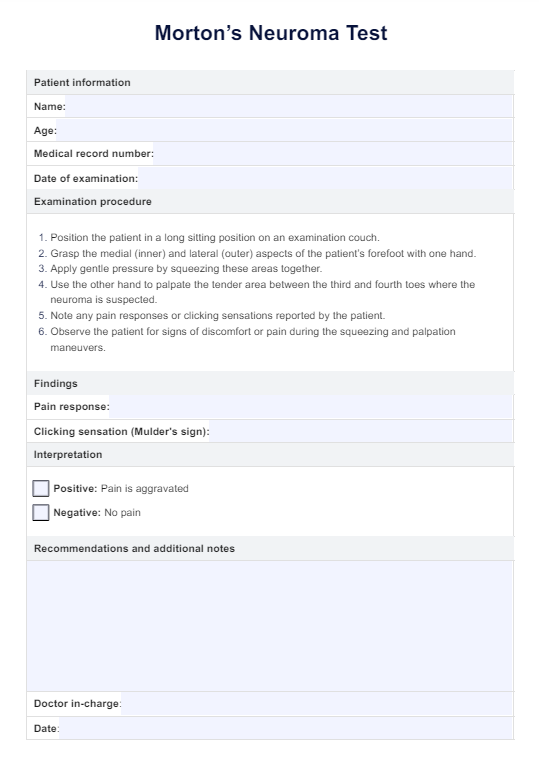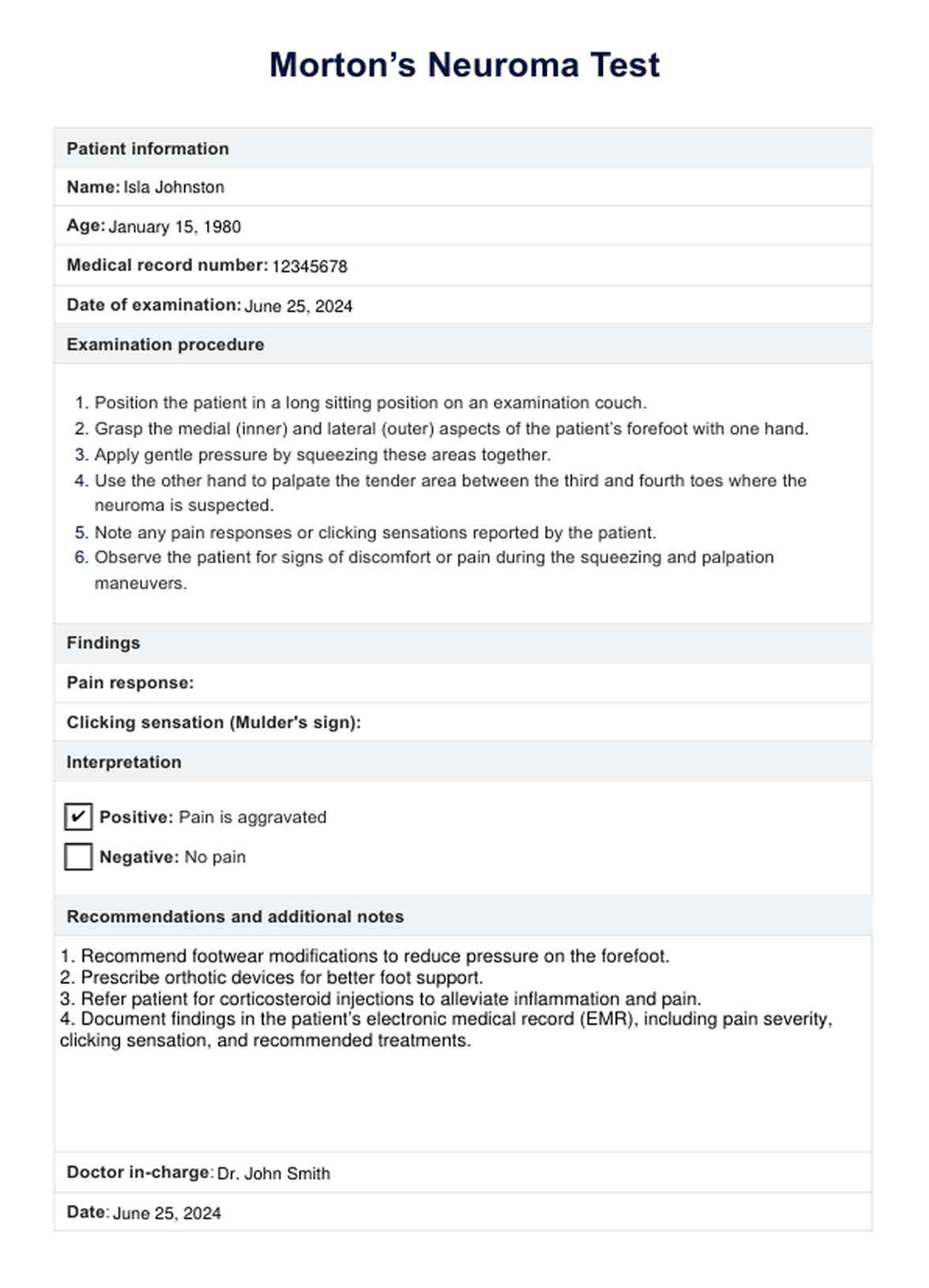Morton’s Neuroma Test
Learn about Morton's neuroma and how it is tested with Carepatron's free PDF download. Use our guide and template to understand this condition better.


What is Morton’s neuroma?
Morton’s neuroma, often referred to simply as Morton neuroma, is a painful condition that affects the foot, specifically the area between the third and fourth toes. It is characterized by a thickening of the tissue around one of the nerves leading to the toes, usually due to compression or irritation. This compression can result in significant discomfort, typically described as burning pain or the sensation of standing on a pebble.
The condition is frequently associated with activities that involve repetitive pressure on the forefoot, such as running or wearing tight shoes. Individuals suffering from Morton’s neuroma may experience relief by removing their shoes and massaging the affected foot. However, persistent symptoms may require medical intervention, including corticosteroid injections or physical therapy. In severe cases, Morton neuroma surgery may be recommended to relieve pressure on the affected nerve and reduce pain.
Morton's neuroma and interdigital neuroma are terms often used interchangeably, but they technically refer to slightly different conditions. Morton's neuroma compared to interdigital neuroma is a broader term that encompasses any neuroma (a benign growth of nerve tissue) occurring between the toes, not limited to the third and fourth toes like Morton's neuroma.
It’s important to note that Morton’s neuroma should not be confused with stump neuroma formation, which occurs post-surgery in some cases. Compared to other conditions causing forefoot pain, such as Morton's neuroma, physical medicine approaches are crucial in the management of these conditions
Symptoms of Morton’s neuroma
Morton’s neuroma can manifest through several distinct symptoms, which typically develop gradually and worsen over time. Recognizing these signs is crucial for early intervention and effective management. Common symptoms include:
- Persistent pain in the ball of the foot or between the toes
- Sensation of a lump or thickening in the affected area
- Tingling or numbness in the toes
- Burning pain that radiates from the ball of the foot to the toes
- Feeling as if there is something inside the shoe or a fold in the sock
- Pain that worsens with activities like walking or wearing narrow shoes
These symptoms may vary in intensity, with some individuals experiencing occasional discomfort while others endure constant pain.
Causes of Morton’s neuroma
Morton’s neuroma develops primarily due to irritation, compression, or injury to the nerve that serves the toes, typically between the third and fourth toes. The exact causes can vary, but common contributing factors include wearing high-heeled shoes or footwear that is too tight, which puts pressure on the forefoot pain and compresses the nerve. Activities or occupations that involve repetitive stress on the feet, such as running or jobs that require prolonged standing, can also increase the risk of developing Morton’s neuroma.
Certain foot deformities or conditions, such as bunions or hammertoes, may exacerbate the problem by altering the mechanics of the foot and placing additional stress on the nerves. In some cases, trauma or injury to the foot can lead to the formation of Morton’s neuroma.
Morton’s Neuroma Test Template
Morton’s Neuroma Test Example
What is the Morton’s Neuroma Test?
Morton’s Neuroma Test, often referred to simply as Morton neuroma test or the metatarsal squeeze test, is a clinical procedure used to diagnose Morton’s neuroma, a condition involving the thickening of tissue around the nerve between the third and fourth toes. This test helps identify the presence of the neuroma by applying pressure to the affected area and observing for symptoms such as pain or a clicking sensation, known as Mulder's sign or Mulder's click. This maneuver helps to pinpoint nerve compression or irritation, which are characteristic of Morton’s neuroma.
How is this test conducted?
The Morton's Neuroma Test is a simple yet effective procedure to diagnose the presence of Morton’s neuroma. Here are the steps typically followed during the test:
- Position the patient: The patient is asked to sit with their legs extended (long sitting) on an examination couch.
- Grasp the forefoot: The examiner uses one hand to grasp the medial (inner) and lateral (outer) aspects of the patient's forefoot.
- Squeeze the forefoot: The examiner then squeezes these medial and lateral parts of the foot together.
- Palpate the tender area: While maintaining the squeeze, the examiner uses their other hand to palpate the area between the third and fourth toes, where the pain is typically felt.
- Observe for pain: A positive test is indicated by the aggravation of foot pain during this maneuver, suggesting the presence of Morton’s neuroma.
How are the results interpreted?
The results of the Morton’s Neuroma Test are interpreted based on the patient’s response to the applied pressure and palpation during the examination.
- Positive result: A positive test is indicated if the patient experiences a sharp, localized pain or a clicking sensation in the forefoot area, particularly between the third and fourth toes. This pain is typically aggravated by the squeezing and palpation maneuvers performed by the examiner. A positive result suggests the presence of Morton’s neuroma, where the affected nerve is compressed or irritated, leading to the characteristic symptoms. This may also be accompanied by a Mulder's click.
- Negative result: A negative test occurs when the patient does not report any significant pain or discomfort during the test. The absence of pain or clicking sensation suggests that Morton’s neuroma is unlikely to be the cause of the foot pain, and further investigation may be needed to identify other potential causes.
Next steps after conducting this test
After conducting the Morton's Neuroma Test, the next steps depend on the test results. If the test is positive, indicating the presence of Morton’s neuroma, the healthcare provider may recommend several treatment options. These could include conservative measures such as changing to more supportive footwear, avoiding tight shoes, and using orthotic devices to ease pressure on the affected nerve.
Physical therapy and corticosteroid injections may also be considered to reduce inflammation and pain. In cases where conservative treatments fail to provide relief, surgical intervention, as outlined in J Foot Ankle Surg, may be necessary to remove the neuroma. If the test is negative, further diagnostic tests, such as imaging studies, may be performed to identify other possible causes of foot pain.
How to use our Morton’s Neuroma Test template
Carepatron's Morton’s Neuroma Test template provides a structured approach for medical professionals to conduct and document the examination efficiently. By following the template, healthcare providers can ensure standardized evaluation and accurate documentation of findings. Here are the steps to effectively utilize Carepatron's template:
Accessing the template
Access the Morton’s Neuroma Test template within Carepatron's platform. You can find it in the Resource Library.
Performing the examination
Follow the step-by-step instructions provided in the template to position the patient correctly and perform the Morton’s Neuroma Test. Use the template's prompts to guide you through grasping the forefoot, applying pressure, and palpating the tender areas.
Documenting findings
Utilize the template to document the patient's responses and any observed symptoms during the examination. Record whether the test results were positive or negative for Morton’s neuroma.
Implementing treatment plans
Based on the test results documented in the template, develop and implement appropriate treatment plans. This may include recommending footwear modifications, orthotic devices, physical therapy, corticosteroid injections, or surgical intervention as needed.
Morton’s neuroma treatment options
Treatment for Morton’s neuroma depends on the severity of symptoms and may vary from conservative measures to surgical intervention. Initially, lifestyle modifications such as wearing wider shoes with lower heels or using orthotic devices to relieve pressure on the affected nerve can help alleviate discomfort. Padding or taping the foot may also relieve pain by redistributing pressure.
For more persistent symptoms, corticosteroid injections can be administered to reduce inflammation and pain in the affected area. Physical therapy or extracorporeal shockwave therapy may be recommended to improve foot mechanics and reduce stress on the nerve. In cases where conservative treatments fail to provide relief, surgical options such as ultrasound-guided alcohol ablation or Morton's neuroma surgery (usually involving surgical excision) may be considered to permanently alleviate symptoms.
Commonly asked questions
Morton's neuroma is often tested using physical maneuvers such as the Mulder's click test, where pressure is applied to the affected area to reproduce symptoms like pain or a clicking sensation indicative of the condition.
Conditions such as stress fractures, arthritis, bursitis, or even metatarsalgia (pain in the ball of the foot) can be mistaken for Morton's neuroma due to overlapping symptoms of foot pain and discomfort.
The classic symptom of Morton's neuroma is a sharp, burning pain or the sensation of standing on a pebble between the third and fourth toes, often worsened by walking or wearing tight shoes.







































































































